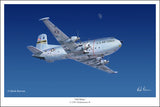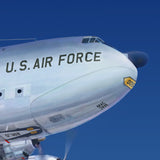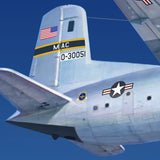Developed from the C-74 Globemaster, the C-124 Globemaster II was the primary heavy-lift transport for the US Air Force during the 1950s and early 1960s. The aircraft featured two large clamshell doors in the nose as well as an elevator in the rear fuselage both of which facilitated loading of large amounts of cargo. Inside the cargo bay was fitted with two overhead hoists, each capable of lifting 8,000 lb. It also could be arranged into a double-deck configuration via a mid-section floor which was normally folded up to the interior sides of the fuselage when in the full cargo, single bay configuration.
The C124 could carry up to 68,000 lb of cargo including bulldozers, light tanks, trucks, and small aircraft/helicopters. It was the only aircraft of its time which could transport such fully assembled, heavy equipment. It could carry up to 200 fully equipped troops when in its double-deck configuration.
The C-124 first flew on 27 November 1949. C-124A models began delivery to the Air Force in May of 1950. The later C-124C version was developed next; its most distinguishing feature being an APS-42 weather radar fitted in a radome housing protruding from the nose. The version also featured more powerful engines as well as wingtip mounted combustion heaters which provided heat for the cabin and deicing capability for the wing and tail surfaces.
C-124s were operational during the Korean War and were used extensively during the Vietnam War. They were used for US military heavy lift cargo operations worldwide, including flights to Southeast Asia, Africa as well as transporting Thor missiles across the Atlantic to England. They were also used in Antarctica for supply operations during Operation Deep Freeze.
The C-124 Globemaster II was affectionately known as "Old Shaky" to its crew due to its propensity to shake during flight. Globemaster II aircraft were truly amazing workhorses of their day. They were eventually replaced by the C-141 Starlifter.








